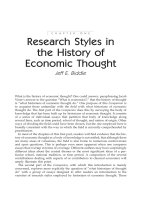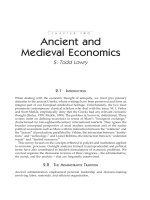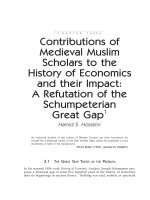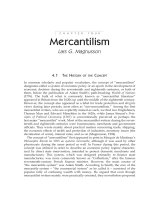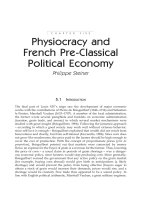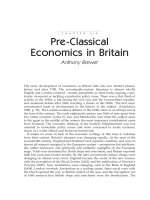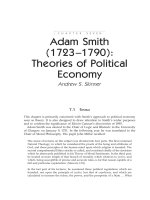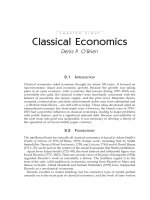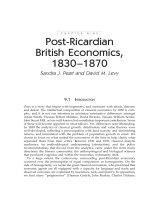A Companion to the History of Economic Thought - Chapter 27 pdf
Bạn đang xem bản rút gọn của tài liệu. Xem và tải ngay bản đầy đủ của tài liệu tại đây (202.63 KB, 17 trang )
428 S. G. MEDEMA
CHAPTER TWENTY- SEVEN
The Economic Role
of Government
in the History of
Economic Thought
Steven G. Medema
27.1 INTRODUCTION
The question as to the appropriate role for government within the economic
system is as old as economic thought. For much of that history, the economy was
seen as but one piece of a larger social system and the study of economics, or
political economy, as one facet of a larger social theory. Only with the advent
of commercial society and the organization of economic activity more overtly
within the context of the market did the perception of the economy as a quasi-
independent part of the social system begin to gain currency. This has a number
of implications, but for present purposes one stands out: the earlier economic
literature envisioned a system wherein government and economy are integrally
linked aspects of the social system, whereas in later literature government and
economy – or government and market – are often viewed as independent spheres
of action, with corresponding questions as to how much one should “intrude”
upon the other.
The perspectives that motivate or underlie the discussion of the appropriate
economic role for government are many and diverse; the resulting analysis thus
reflects diverse and often contradictory accounts of the appropriate economic
tasks for government. This vast topic requires the selective adoption of an organ-
izing principle, and that adopted here is “the economic role of government as a
THE ECONOMIC ROLE OF GOVERNMENT 429
response to the forces of self-interest.” While this necessarily excludes a variety
of contributions and perspectives, it provides the vehicle for a useful analysis of
how the economic role of government has been viewed throughout the history of
economic thought and analysis, and the forces that have motivated these views.
27.2 PRE-CLASSICAL ECONOMICS
One defining characteristic of much pre-classical economic thought is its natural-
istic, or natural law, orientation – an orientation reflected in the roles ascribed to
government by these scholars. This a priori approach to the subject made the role
of government something given rather than something to be worked out. We
find here no deep theory of governmental behavior and no serious analysis of the
ability of government to carry out the tasks ascribed to it by these authors. There
is, rather, an assumed natural order of things and consequent statements of how
government should act so as to facilitate the operation of a social–economic
system that comports with the dictates of natural law.
27.2.1 The Greeks and Scholastics
The Greek contribution to economic thought arises primarily through the works
of Plato (e.g., in Republic and Laws) and Aristotle (e.g., in Politics and Ethics).
Their analysis centered around the polis, or city–state, and what, ideally, would
constitute “the good life.” An important aspect was justice, including the role to
be played by the governing authority. The economic upheaval against which
Plato and Aristotle discussed economic issues was seen to be a consequence of
the surge in economic growth following the liberalization of commercial activity,
including the expansion of international trading activity. Given what they saw as
the undesirable effects of economic growth, their analysis centered on the estab-
lishment of a relatively stationary state of economic activity accompanied by a
reasonable standard of economic well-being.
For Plato and Aristotle, the most straightforward means of attaining their
objectives for the ideal state was through relatively strict limits on commercial
activity in which the state was to play a central role. A system of laws should be
so structured as to facilitate a stationary state with a reasonable level of economic
well-being for all citizens. Aristotle saw the market as a “creature of the state”
(Lowry, 1987, p. 237); with this came prescriptions for the regulation of commer-
cial dealings. For example, both Plato and Aristotle recognized that a satisfactory
level of material well-being required the harnessing of the division of labor. This
should be conducted such that natural roles were enforced (Plato) or at least
given effect by government (condoning slavery, by Aristotle). Both Plato and
Aristotle objected to the internationalization of the division of labor, which they
believed introduced base influences into society; various government actions
– such as separate domestic and international trading currencies – were recom-
mended to mitigate incentives to seek private gain through foreign trade.
Commercial activity in general was frowned upon, and at best was seen as a
430 S. G. MEDEMA
necessary evil to equalize needs and possessions. Policies – including prohibi-
tions against lending at interest, the elimination of profits, and statutory fixation
of prices – were recommended to control commercial activity.
Certain significant parallels existed between the respective analyses of the Greeks
and the Scholastics, derivative of St. Thomas Aquinas’s attempt to reconcile Church
teachings with the work of Aristotle. Their analysis of the relationship between
man and his creator, an aspect of which is the relation between individuals
in a social context, led the Scholastics to consider commodity exchanges and
monetary issues from a Christian moral perspective. The “economic problem,” in
a sense, was man’s sinful nature, the effect of which, if left unchecked, was to
promulgate outcomes contrary to the dictates of Christian justice if unchecked by
religious and civil laws.
While viewing common property as the ideal (evidenced in communal mon-
astic institutions), the Scholastics believed that private property was optimal for
society as a whole, owing to the negative incentive effects that common property
provides for sinful, worldly people – a religious variant of Aristotle’s position.
Unlike Plato and Aristotle, the Scholastics were more favorably disposed to
commercial activity, generally believing that market outcomes would satisfy the
dictates of justice in the absence of monopoly or fraud. Following Aquinas, the
early Scholastics supported prohibitions on lending at interest, although this
view slowly eroded as later scholars came to understand the opportunity cost of
lending. Concern over the harmful effects on purchasing power that could come
with macroeconomic fluctuations led many Scholastics to support some degree
of price control – the regulation of prices within certain upper and lower limits –
in order to mitigate fluctuations in the value of money.
For both Greek and Scholastic writers, relatively extensive government activity
was a necessity to create a harmonious social–economic order. Instead of an
over-arching theory of the state, there was a set of supposedly naturally ordained
ends that government could (and should) assist society in attaining. In particular,
the operation of self-interest was seen as promoting outcomes inconsistent
with those prescribed by nature or by God; government action was necessary to
prevent, or at least minimize, the more base impacts of self-interested behavior.
27.2.2 Mercantilism
Mercantilist political economy differed from its predecessors in the relative lack
of emphasis given to questions of value and distribution, but the mercantilist
goal of nation–state building, combined with their notion that national political–
economic strength entailed running a trade surplus payable in bullion, engen-
dered a view of government policy involving extensive regulation of economic
affairs. Continuity with Greek and Scholastic thought is found in the view that
individual self-interest, if given free reign, would run against the national inter-
est, although moral qualms were replaced by the mercantilists’ more worldly
concerns. Self-interest was bound to engender excessive consumption of both
domestic and foreign goods, thereby diminishing the quantity and raising the
price of goods for export (reducing their competitiveness on world markets) and
THE ECONOMIC ROLE OF GOVERNMENT 431
increasing imports – thus harming the trade balance and the nation’s stock of
precious metals.
Mercantilism melded political and economic policy under the nationalistic
banner. That political and economic objectives were mutually reinforcing can
be seen by noting that bullion accumulation was accompanied by the develop-
ment of military (including naval) power, which protected both nation and trade
shipments; the acquisition of colonies, which brought empire, sources of raw
materials for manufacturing, and markets for exports; and the slave trade, which
supplied low-cost labor. For the mercantilists the test of policy proposals was
the effect on the nation’s stock of precious metals. As Lars Magnusson (1993,
pp. 6–8) has pointed out, mercantilism departed from previous thinking by view-
ing the economic system as “an independent territory with its own distinctive
laws.” Here, economic welfare “more than anything else depended upon the
statesman’s ability to rule according to the laws dictated by an independent
economic realm;” such was necessary because of the inability of self-interested
private action, as translated through the market mechanism, to maximize national
wealth defined as stocks of precious metals.
This was to be accomplished through a scheme of economic policy of which
import restriction and export promotion were only the most obvious com-
ponents. Other policies included the regulation of precious metal exchanges,
including prohibitions on bullion exports, exchange control, protecting the quality
of coinage, and related regulations restricting the hoarding of bullion and its
conversion into plate, jewelry, and so on in order to ensure sufficient circulating
currency to fuel the nation’s economic activity. Strategic policies favoring certain
important national industries and protecting infant industries were popular, as
were labor-related policies – including loose immigration and tight emigration
rules, and subsidies to encourage workers to relocate to manufacturing centers
– which served to keep labor supply up and wages low, thus facilitating the
price-competitiveness of exports.
27.2.3 Physiocracy
The backlash against mercantilist thinking was first significantly found among
the eighteenth-century French physiocratic thinkers who reacted against Colbert’s
policies promoting manufacturing at the expense of agriculture. These policies,
combined with wars and high tax burdens, impoverished the agricultural peasant
proprietors and retarded productivity advances in the agricultural sector.
The physiocrats saw the world as comprising a set of self-evident truths aris-
ing from natural law. These natural laws extended to the economic system,
and physiocrats considered agricultural production the cornerstone of economic
activity, arguing that it alone generated a net product – a surplus of output over
input; manufacturing was sterile. The net product was the sole source of funds
for investments in increased productivity. François Quesnay and the other
physiocrats saw the maximization of this surplus as providing the means
of advancing agricultural technology to match the production of other nations.
Unchecked, consumers would make excessive expenditures on manufactured
432 S. G. MEDEMA
goods (luxe de decoration); this, combined with the mercantile system in place,
worked to impede the growth of the net product.
All policy proposals were to be judged by their effect on net product. The
physiocrats therefore were steadfastly against policies restricting agricultural pro-
duction in favor of manufacturing – such as prohibitions on agricultural exports
that kept food prices, and thereby manufacturing wages, low. Against mercant-
ilist policy, Quesnay argued that the sole function of the state is the provision of
security – national defense and the appropriate system of laws (those harmon-
izing with natural law). The physiocrats’ opposition to government interfer-
ence with commerce is evident from Quesnay’s essay “Corn,” where he argues
that “all trade ought to be free . . . It is enough for the government to watch over
the expansion of the revenue of the kingdom’s property; not to put any obstacles
in the way of industry; and to give the people the opportunity to spend as they
choose . . .” (in Meek, 1962, p. 79; see also p. 237). This freedom entailed freedom
in the production and circulation of goods, the reduction or elimination of
transport tolls, improving transportation infrastructure, and eliminating the tax
system oppressing agriculture in favor of a single tax on the net product.
But physiocratic support for laissez-faire was, in actuality, selective (Samuels,
1962; Steiner, 2002). In addition to the loosening of restrictions on agricultural
production, they advocated agricultural price supports, legal limits on interest
rates to minimize the cost of borrowing for agricultural proprietors, and restric-
tions on the export of manufactured products – because export promotion led to
political pressures to hold down food prices in order to keep manufacturing
wages/costs low. As Samuels (1962, p. 149) has pointed out, far from proposing
a minimalist and inactive state, the physiocrats looked to achieve their aims
“through the agency of the political state,” the substitution for mercantilist poli-
cies of policies that favored the agricultural sector and the interests it represented
– as evidenced in Quesnay’s statement in “Maxims” that “the government’s
economic policy should be concerned only with encouraging productive [i.e.,
agricultural] expenditures and trade in raw produce . . .” (in Meek, 1962, p. 233).
Quesnay’s Tableau was deployed to “demonstrate” both the error of Colbert’s
policies and the benefits of physiocratic policy proposals.
27.3 CLASSICAL ECONOMICS
27.3.1 Adam Smith and the system of natural liberty
The physiocratic revolt against mercantilism was extended by Adam Smith in the
Wealth of Nations. For Smith, the wealth of a nation consisted in the value of its
produce rather than in the national stock of precious metals or the net product of
agriculture, and government’s role was to facilitate the growth of national wealth,
so defined. In this sense, Smith demonstrated an important commonality with
the mercantilist and physiocratic writers, but the accomplishment of the goal of
maximizing the value of output required a very different role for government
than that posited by earlier writers.
THE ECONOMIC ROLE OF GOVERNMENT 433
Smith’s critiques of mercantilism and physiocracy were parallel; he saw their
respective favoritisms as promoting flows of resources to the favored sectors
in amounts greater than would otherwise obtain. The question is whether this
is good for or harmful to the interests of society. Smith is unequivocal: “Every
individual is constantly exerting himself to find out the most advantageous em-
ployment for whatever capital he can command. It is his own advantage, indeed,
and not that of society, which he has in view. But the study of his own advantage
naturally, or rather necessarily leads him to prefer that employment which is
most advantageous to society” (Smith, 1776, p. 421). Self-interest is not some-
thing to be suppressed, as with the Greeks and Scholastics, nor even to be shunted
down a particular road, as with the incentives offered by the mercantilists
and physiocrats. Rather, the free play of self-interest is said to redound to the
benefit of society as a whole. In Smith’s view, the individual is “led by an invis-
ible hand to promote an end which was no part of his intention” (p. 423). Given
this propensity on the part of the individual and the associated positive (if
unintended) consequences:
The statesman, who should attempt to direct private people in what manner they
ought to employ their capitals, would not only load himself with a most unneces-
sary attention, but assume an authority which could safely be trusted, not only to no
single person, but to no council or senate whatever, and which would nowhere be
so dangerous as in the hands of a man who had folly and presumption enough to
fancy himself fit to exercise it. (p. 423)
But it is not simply a matter of government officials being, in Smith’s view,
incapable; for Smith, the market system does not require such overt direction.
Attempts by government to channel self-interest in some direction inhibit rather
than promote the growth of wealth (pp. 650–1) and, in doing so, enrich special
interests at the expense of society as a whole. Smith states the basic framework of
his view of the economic role of government as follows:
All systems either of preference or restraint, therefore, being thus completely taken
away, the obvious and simple system of natural liberty establishes itself of its own
accord. Every man, as long as he does not violate the laws of justice, is left perfectly
free to pursue his own interest his own way, and to bring both his industry and his
capital into competition with those of any other man, or order of men. The sover-
eign is completely discharged from a duty, in the attempting to perform which he
must always be exposed to innumerable delusions, and for the proper performance
of which no human wisdom or knowledge could ever be sufficient; the duty of
superintending the industry of private people, and of directing it towards the
employments most suitable to the interest of society. (p. 651)
What, then, is the appropriate role for government within such a system?
“According to the system of natural liberty, the sovereign has only three duties
to attend to,” the provision of national defense, the provision of civil justice, and
“the duty of erecting and maintaining certain public works and certain public
institutions” which could not be profitably provided by the private sector but
434 S. G. MEDEMA
which provide a net benefit to society (p. 651). These last include the standard
roads, bridges, canals, and harbors – which serve to facilitate commerce – but
also education, to counteract what he saw as the mind-numbing effects of the
division of labor, temporary monopolies given to joint-stock companies to facilit-
ate new trade avenues, and religious instruction for clergy. Smith also allows for
exceptions to free trade to encourage and protect industries essential to national
defense, to level the playing field for domestic products subject to tax at home,
and retaliatory tariffs inducing other countries to lower their trade barriers.
Smith was not a doctrinaire advocate of laissez-faire. He was, on the one hand,
in favor of doing away with the trade restrictions of the mercantilists, apprentice-
ship and settlement laws (which inhibited the free flow of labor), legal monopoly,
and the laws of succession that impeded free trade in land. But, in addition to the
basic governmental functions noted above, he supported regulation of public
hygiene, legal ceilings on interest rates (to prevent excessive flows of financial
capital into high-risk ventures), light duties on imports of manufactured goods,
the mandating of quality certifications on linen and plate, certain banking and
currency regulations to promote a stable monetary system, and the discourage-
ment of the spread of drinking establishments through taxes on liquor (one of
various regulations Smith advocated to compensate for individuals’ imperfect
knowledge – or diminished telescopic faculty). (For an excellent elaboration of
Smith’s rather broad-based conception of the appropriate functions for the state,
see Skinner, 1996.)
Smith was inherently suspicious of government’s ability to properly manage
economic affairs, but he also recognized that there were various policies that
could improve national welfare. Equally important, however, was Smith’s re-
cognition that the market does not operate without government; indeed, Smith
calls political economy “a branch of the science of a statesman or legislator”
(p. 397), making it, in part at least, a branch of jurisprudence. Smith found in
the system of natural liberty a regulating mechanism not discerned by previous
commentators – a coordinating force keeping self-interest from becoming tot-
ally destructive. But he also understood that governmental action supplies the
legal–institutional process through and within which markets function. It was
not government that Smith was opposed to; rather, he was after the appropriate
set of policies to facilitate the growth of wealth.
27.3.2 The nineteenth-century classical economists and
the program of economic reform
Many writers caricature both Smith and the nineteenth-century classical eco-
nomists as rigorous adherents of laissez-faire. In both instances, the caricature is
misleading. The classicals were strongly reformist, critical of numerous institu-
tions of their time, and highly optimistic that the insights of political economy
could be used to create socially beneficial economic policy.
The classicals, like Smith, were cognizant of the virtues of the market as
an allocation mechanism, but they also understood that the market could only
THE ECONOMIC ROLE OF GOVERNMENT 435
operate satisfactorily – harmonizing actions of self-interested agents with the
interests of society as a whole – within a framework of legal, political, and moral
restrictions. Seeming hostility to government is manifest throughout classical
economics (a legacy of Smith’s harsh critique of mercantilism), but a careful
reading of the classical writings will reveal that the classicals had a relatively
pragmatic view of the economic role of government (Robbins, 1952; Samuels,
1966; O’Brien, 1975). Witness J. R. McCulloch, who argued that “The principle of
laisser-faire may be safely trusted to do in some things but in many more it is
wholly inapplicable; and to appeal to it on all occasions savours more of the
policy of a parrot than of a statesman or a philosopher” (McCulloch, 1848, p. 156;
quoted in Robbins, 1952, p. 43). Likewise, Nassau Senior argued, “the only
rational foundation of government, the only foundation of a right to govern and
a correlative duty to obey is, expediency – the general benefit of the community”
(Senior, 1928, vol. ii, p. 302; quoted in Robbins, 1952, p. 45). The classicals were
concerned with determining the set of policies promoting society’s best interests
and were vociferously opposed to policies that they believed served the interests
of particular groups at the expense of the larger population. Their consumption-
oriented view led them to the belief that freedom of choice was desirable for
consumers, and that freedom for producers was the most effective means of
satisfying consumer desires. The impersonal forces of the market, working through
the system of natural liberty, would then serve to harmonize these interests – at
least to a greater and more beneficial extent than other systems.
The classical justification for private property (with its encouragement of
industry) and security of contract (with its associated encouragement of exchange)
is found in this general utility, rather than from some preconceived notion of
natural rights or natural law. Robbins (1952, p. 56) even suggests that Smith’s
“invisible hand” is actually government itself: it “is not the hand of some god or
some natural agency independent of human effort; it is the hand of the law-giver,
the hand which withdraws from the sphere of the pursuit of self-interest those
possibilities which do not harmonize with the public good.” For the classicals,
therefore, the state was neither a simple night watchman nor a broad planner.
The most basic function of government was the establishment and enforcement
of a system of law that would control, channel, and restrain individual action so
that individual pursuit of self-interest would create the greatest happiness.
The accomplishment of this greatest happiness required far more than the
establishment of a system of laws to facilitate the market, combined with the
Smithian notion of defense, justice, and the provision of certain public works.
Indeed, the scope for government action expanded as the classicals’ period
unfolded. The classicals were consistently opposed to monopoly, price (including
interest rate) regulation, and taxation and regulation of the production process
(especially foodstuffs). But numerous additional functions – varying across writers
– were ascribed to government as necessary to the public interest, including
public health regulations, public provision of medical care, building regulations
(to combat the emerging industrial slums), industrial safety and health regulations
and employer liability for injuries caused by the failure to meet standards, regu-
lation of prices charged by public utilities, and factory legislation restricting the
436 S. G. MEDEMA
work of children. The classicals generally supported the right of workers to form
trades unions, except to the extent that membership was mandatory and unions
had a monopolizing effect on the labor market (consistent with their general
opposition to monopoly). Malthus and Ricardo favored the abolition of the Poor
Laws, doing so largely because they believed the Poor Laws to be ineffective –
reducing industry and increasing the population. Later classicals advocated more
moderate Poor Law reforms, making the position of relief recipients inferior to
laborers in order to encourage work and reduce population pressure.
J. S. Mill’s contribution in his Principles (originally published in 1848) is
emblematic of both the continuity within the classical tradition reaching back to
Smith and a transition toward the increasing recognition of market failures that
characterizes neoclassical economics. Mill’s (1909 [1871], p. 800), criterion for the
boundaries of the appropriate functions of government was neither strict nor
a priori; it was “expediency.” Mill’s “necessary” functions of government, where
the case for expediency is obvious, are extremely broad; even things seemingly as
simple as the enforcement of property and contract cannot, according to Mill, be
as circumscribed as many would think. In the case of property:
It may be imagined, perhaps, that the law has only to declare and protect the right
of every one to what he himself has produced, or acquired by the voluntary consent,
fairly obtained, of those who produced it. But is there nothing recognized as prop-
erty except what has been produced? Is there not the earth itself, its forests and
waters, and all other riches, above and below the surface? These are the inheritance
of the human race, and there must be regulations for the common enjoyment of it.
What rights, and under what conditions, a person shall be allowed to exercise over
any portion of this common inheritance cannot be left undecided. No function of
government is less optional than the regulation of these things, or more completely
involved in the idea of civilized society. (p. 797)
Likewise, with contracts, “governments do not limit their concern . . . to a
simple enforcement [of the product of voluntary consent]. They take upon
themselves to determine what contracts are fit to be enforced” (p. 798).
In discussing the limits of laissez-faire, Mill criticized ideologues on both poles,
contending that the issue of the appropriate boundaries for government action
“does not . . . admit of any universal solution” (pp. 941–2). Mill found it import-
ant to distinguish between two forms of government action: the authoritative,
in which certain types of conduct are prescribed or proscribed, and the non-
authoritative, where government provides, for example, advice, information,
services, institutions, and so on, which are thereby available but do not impinge
upon freedom of choice and action. The former, he argues, “has a much more
limited sphere of legitimate action” and “requires a much stronger necessity to
justify it” (p. 942). Mill sees “a circle around every human being which no
government . . . ought to be permitted to overstep,” and, for him, this circle should
include “all that part which concerns only the life . . . of the individual, and does
not affect the interests of others, or affects them only through the moral influence
of example” (p. 943). Mill is arguing for freedom of individual action where
THE ECONOMIC ROLE OF GOVERNMENT 437
externalities are not present; where externalities do exist, however, the situation
is altered. People are not always the best judge, he says – for example, regarding
education for either themselves or their children. He supports public provision
of education (pp. 953–4), but he also maintains that government should not
monopolize it. He adopts a similar view with regard to public charity, coloniza-
tion, scientific exploration, and the maintenance of a learned class – functions
that, as with public works, substantially further the interests of society but
which, he argues, will not be provided in sufficient amounts through voluntary
mechanisms.
In spite of his relatively extensive elaboration of legitimate governmental func-
tions, Mill contends that government is poorly organized to carry out many of
the tasks that people would wish it to undertake, and that, even if well organ-
ized, the related information issues and incentives are such as to make private
efforts superior to governmental ones in carrying out many tasks (pp. 945–7).
As such, a society should restrict “to the narrowest compass the intervention of
a public authority in the business of the community,” and the burden of proof
should fall “on those who recommend, government interference” (p. 950). His
prescription? “Laisser-faire, in short, should be the general practice: every departure
from it, unless required by some great good, is a certain evil” (p. 950).
27.4 THE “INTERVENTIONIST” TURN: MARGINALISM AND
THE
DEVELOPMENT OF NEOCLASSICAL WELFARE ECONOMICS
The marginal revolution helped change how economists analyzed the economic
role of government. Normative analysis faded from the scene; writings on public
finance largely ceased to discuss the appropriate role of government and were
confined to how to raise the revenues necessary for the operation of govern-
ment (Baumol, 1952, p. 154). Discussion of the role of government shifted to the
newly emerging welfare economics. More than positivist philosophy drove these
developments. Externally, late-nineteenth- and twentieth-century economists
saw the effects, both positive and negative, of widespread industrialization and
increasing congestion. Internally, the tools of marginal analysis made possible
the demonstration of the potential failings of the system of natural liberty and,
therefore, the possibilities of governmental policy actions for promoting, rather
than diminishing, social welfare.
27.4.1 Henry Sidgwick: dismantling the system of
natural liberty
Mill’s premonitions of externality-related market failure were further developed
by Henry Sidgwick. Sidgwick (1901, p. 402) accepted that “the motive of self-
interest does work powerfully and continually.” Yet, he argued, the fact that the
system works does not mean that it functions optimally in all times and places.
“[E]ven in a society composed – solely or mainly – of ‘economic men,’” he wrote,
“the system of natural liberty would have, in certain conditions, no tendency to
438 S. G. MEDEMA
realize the beneficent results claimed for it” (pp. 402–3). Unlike Marx, who main-
tained that supposed governmental corrective policies would be ineffective at
best and would in many instances even further destabilize the market system,
Sidgwick stood with Mill, contending that governmental corrective actions could
counter many of the negative effects of self-interested behavior.
In discussing the harmful nature of external effects, Sidgwick anticipated Ronald
Coase’s “The problem of social cost” (1960), writing that “In a perfectly ideal
community of economic men all persons concerned would doubtless voluntarily
agree to take the measures required to ward off such common dangers . . .” But
in reality, he said, “the efforts and sacrifices of a great majority are liable to be
rendered almost useless by the neglect of one or two individuals . . .” (1901,
pp. 409–10). Sidgwick applied marginal analysis to the common pool fisheries
problem to illustrate his point (p. 410), one example of the need for regulation of
the use of natural resources when self-interested agents failed to take into account
the full social impact of their activities (pp. 475–6). In Sidgwick’s opinion, the
general failure to properly account for the interests of future generations, even
among parents, is a potentially serious source of market failure (pp. 412–13).
Freedom of action has other limitations as well. Sidgwick contends that
people are at times unable to see their own bests interests or to take adequate care
of themselves, thereby justifying certain paternalistic actions by government –
hence the need for health regulations on foodstuffs, the licensing of physicians
and other occupations, workplace safety regulations, and various limitations on
freedom of contract (pp. 405–6, 425). He adopts a similar view with regard to
monopoly – not just in the sense that monopoly reduces output and increases
price, but also because the monopolist, by virtue of its privileged position, may
not have any incentive to invest in the development of more economical produc-
tion techniques. Sidgwick also suggests that there are many instances in which
private enterprise will not provide goods and services owing to the inability to
appropriate sufficient returns to justify the investment – for example, lighthouses,
forests (with “their beneficial effects in moderating and equalizing rainfall”),
worker training, inventions, and the “machinery of transfer” (things that facilitate
transactions and exchange). This last instance provides a still more sophisticated
case for governmental provision of traditional public works, including roads,
canals and railways, telegraph and postal services, and light and water, as well
as the provision of currency: government becomes the facilitator of commerce and
the market rather than an impediment to it.
The widespread failure of public and social interests to coincide means that, in
such cases, governmental interference needs to be regarded not merely as “a
temporary resource, but not improbably [as] a normal element of the organ-
ization of industry” (p. 414). Sidgwick acknowledges that market failures do
not inevitably imply the need for government corrective action because its
drawbacks may be more severe than those of the market failure itself (p. 414).
These “drawbacks and disadvantages” include government using its power for
corrupt purposes; the desire to please special interest groups; “wasteful expend-
itures under the influence of popular sentiment;” supervisory problems, given
the expanded range of government activities; the tax cost associated with these
THE ECONOMIC ROLE OF GOVERNMENT 439
operations of government; and the lack of incentives for government workers to
properly carry out their functions (pp. 414–15). But, Sidgwick argues, “moral and
political progress [in society] may be expected to diminish” these disadvantages
(p. 416), thereby eventually increasing the range of activities that government can
carry out in a manner superior to market forces.
27.4.2 A. C. Pigou and Pigovian welfare theory
It was the triumph of A. C. Pigou to graft the analysis of the potential for market
failure evidenced in Sidgwick to the emerging theoretical apparatus of marginal
analysis (see O’Donnell, 1979). In his Economics of Welfare (1932), Pigou examined
“how far the free play of self-interest, acting under the existing legal system,
tends to distribute the country’s resources in the way most favourable to the
production of a large national dividend, and how far it is feasible for State action
to improve upon ‘natural’ tendencies” (p. xii).
Of the various instances of divergence between private and social interests
pointed to by Pigou, perhaps the most important, in terms of long-run impact on
the literature, are situations in which “one person A, in the course of rendering
some service, for which payment is made, to a second person B, incidentally also
render services or disservices to other persons (not producers of like services), of
such a sort that payment cannot be exacted from the benefited parties or com-
pensation enforced on behalf of the injured parties” (p. 183). Pigou distinguishes
between positive externalities, where “marginal private net product falls short of
social net product, because incidental services are performed to third parties
from whom it is technically difficult to exact payment” (pp. 183–4), and negative
externalities, where, “owing to the technical difficulty of enforcing compensation
for incidental disservices, marginal private net product is greater than marginal
social net product” (p. 185). The former case includes lighthouses, parks, roads
and tramways, afforestation, street lighting, pollution abatement, and scientific
research; the latter category includes the effects of such things as congestion and
destruction of amenity from new factories and from new buildings erected in
crowded city centers, the damage to roads from automobiles, the production and
sale of alcohol, and the effects on children from factory labor of women.
Pigou appreciated that divergences between private and social net products
arising between contracting parties – for example, the principal–agent problems
that result from tenancy situations – may be amenable to resolution by negotia-
tion, but he denied negotiation as a viable possibility in situations of third-party
effects. However, he says, the state can act “to remove the divergence in any field
by ‘extraordinary encouragements’ or ‘extraordinary restraints,’” such as taxes and
subsidies (p. 192); in certain more complex cases, regulations – such as zoning
ordinances – may be in order. Pigou is clearly of the mind that large-numbers
externality problems are inevitable and that they invalidate the classicals’ claims
regarding the system of natural liberty: “No ‘invisible hand’ can be relied on to
produce a good arrangement of the whole from a combination of separate treat-
ments of the parts. It is, therefore, necessary that an authority of wider reach
should intervene and should tackle the collective problems of beauty, of air and
440 S. G. MEDEMA
of light, as those other problems of gas and water have been tackled” (p. 195). In
particular, “[i]n any industry, where there is reason to believe that the free play
of self-interest will cause an amount of resources to be invested different from
the amount that is required in the best interest of the national dividend, there is
a prima facie case for public intervention” (p. 331). He goes on, however, to say
that one must assess the government’s qualifications for advantageous interference,
noting that:
It is not sufficient to contrast the imperfect adjustments of unfettered private
enterprise with the best adjustment that economists in their studies can imagine. For
we cannot expect that any public authority will attain, or will even wholeheartedly
seek, that ideal. Such authorities are liable alike to ignorance, to sectional pressure
and to personal corruption by private interest. A loud-voiced part of their constituents,
if organised for votes, may easily outweigh the whole. (pp. 331–2)
One can hear echoes of the qualms of the classical economists. But, following
Sidgwick, Pigou (pp. 333–5) suggests that these problems can often be satisfac-
torily avoided; his view is one of optimism rather than pessimism regarding the
prospects for governmental improvement of the operation of the market.
The subsequent refinement of Pigou’s analysis demonstrated with increasing
analytic rigor the conditions necessary for market optimum, the factors and forces
that would cause market outcomes to diverge from the optimum, and the means
by which governmental action could correct these market failures. While Pigou had
demonstrated the existence of market failure where private and social interests
diverge, his attempts to demonstrate that positive or negative third-party effects
cause market failure relied on logical argument, and his assertions that govern-
ment could remove these divergences with appropriate policy measures were
only assertions. But the groundwork had been laid, and it was not long before
the burgeoning mathematical tools were employed by economists to establish the
necessary conditions for optimality (Bergson, 1938; Lange, 1942; Debreu, 1954),
demonstrating both that externalities did indeed cause departures from the social
optimum and that taxes and subsidies (with rates set equal to the marginal cost
or benefit of the external effect), and regulations, could lead the actions of private
agents to harmonize with the social interest (see, e.g., Meade, 1952).
The quest for determinate, optimal solutions to questions of economic theory
and policy is evidenced vividly in the Pigovian welfare analysis. The shortcom-
ings of the system of natural liberty and the ability of government not only to
improve upon the workings of the market but to generate optimal outcomes
were “proven.” The rhetorical, persuasive force of this analysis should not be
underestimated. This theory demonstrated that perfect markets work perfectly,
imperfect markets work imperfectly, and perfect government can cause imper-
fect markets to also function perfectly. This became the textbook model. Qualms
regarding the ability of government to actually accomplish the correction of mar-
ket failures, so evident in classical economics, had all but disappeared. The role
of government vis-à-vis market was no longer an a priori set of assertions, nor an
opinion based upon casual empiricism; it was demonstrable in the scientific sense.
THE ECONOMIC ROLE OF GOVERNMENT 441
27.5 FROM MARKET FAILURE TO GOVERNMENT FAILURE
Pigou’s conceptualization remained orthodox through the latter part of the
twentieth century, but the beginnings of a challenge emerged in the 1950s and
1960s. This challenge had multiple thrusts; a common thread was the failure of
the received view to account for the potential imperfections associated with gov-
ernment policy – that neoclassical economics had a theory of market failure but
no government failure.
The principal challenge was the theoretical one, exemplified most influentially
in Ronald Coase’s “The problem of social cost” (1960). Coase demonstrated that,
under standard neoclassical assumptions, Pigovian corrective instruments were
not necessary to resolve divergences between private and social costs. Coase
argued that these divergences occurred owing to the failure of government to
assign rights over the resources in question and that, once such rights were
assigned, externalities would be efficiently resolved through negotiation – the
now-famous Coase Theorem (see Medema and Zerbe, 2000). Coase did emphasize
that transaction costs would almost inevitably preclude such efficient bargains
in the real world. But that was not the point: rather, the theoretical apparatus that
had demonstrated the failure of the market and the necessity for government
intervention was shown to be wrong-headed.
A second challenge might be called “empirical” and took multiple forms. The
underlying theme was that while neoclassical theory could demonstrate that
government policies could be used to efficiently correct situations of market
failure, real-world factors and forces, notably information costs, would prevent
the attainment of the social optimum via these policy actions. Coase (1960), for
example, argued that while transaction costs precluded efficient market solutions
to externality problems, costs are also associated with the operation of govern-
ment. These costs are relevant to assessing the efficiency of Pigovian solutions
and might well result in the cure for market failure being worse than the disease.
In a similar vein, the Chicago view of monopoly was that it is either transitory,
an efficient response to market conditions, or exists only because its position
is facilitated by government. Likewise, high levels of industrial concentration
were not viewed as inherently harmful, since rivalrous behavior (e.g., price
competition) on the part of a small number of firms could mimic the results of
competition. As such, monopoly and highly concentrated oligopoly do not neces-
sarily imply the need for government regulatory action. A further empirical strand
was the questioning of the traditional “public goods” story – the inability of the
market mechanism to provide certain goods in optimal amounts owing to the
effects of nonrivalry and nonexcludability. Coase (1974), for example, pointed
out that lighthouses – a classic example of supposed market failure – had been
provided by the private sector in England until well into the nineteenth century.
This literature, in a sense, reverted to the classical approach: policy analysis
informed by a lack of confidence in the ability of government to actually get
things right, in an efficiency sense. These asserted governmental deficiencies were
due less to any underlying model of government behavior and more to beliefs,
442 S. G. MEDEMA
perhaps based on casual empiricism, that markets weren’t as bad as some thought
and government’s potential not so great as the Pigovian theory would lead one
to believe.
The third challenge to the efficacy of government came through public choice
analysis, emanating largely from the Virginia school but also in part from
Chicago. The focus was the examination, largely theoretical, of the operations of
government and the political process generally, using the model of the self-
interested rational actor. As with Pigovian welfare economics, the results indic-
ated a wide range of divergences between private and social interests – here in
the legislative, bureaucratic, and direct democratic voting processes. The demon-
stration was one of government rather than market failure, adding theoretical
force to the pessimism of the classicals and their modern followers, and suggest-
ing that Sidgwickian and Pigovian optimism regarding government intervention
was unfounded. (For surveys of the public choice literature, see Mueller, 1989,
1997.)
This is not to say that by the end of the twentieth century the state of things
had come full circle back to the classical view. Far from it. There was an acknow-
ledgment (in certain quarters, at least) of the inefficiencies of both market and
government. A heterogeneous normative view of the economic role of govern-
ment developed, with individual positions as to the efficacy of markets versus
government resting largely on one’s perspective on whether the limitations of
the market are, in a given set of circumstances, more or less severe than the
limitations of government.
27.6 CONCLUSION
While the focus of this essay has been almost exclusively on “microeconomic”
analyses of market failure and governmental responses to it, these movements
have macroeconomic counterparts: Say’s Law comported with the classicals’
affirmative view of the system of natural liberty. Keynesian macroeconomics
corresponded with Pigovian welfare economics in affirming a broad scope
for activist government intervention. Rational expectations theory reinforced the
microeconomic work of the Chicago and Virginia schools in gaining converts to
macroeconomic noninterventionism. These parallels should not be surprising,
given that the policy issues of macroeconomics – stabilization policy and incomes
policy – are themselves responses to market failure: stability failure and distribu-
tion failure.
Views on the economic role of government in the history of economic thought
have been, from the beginning, enmeshed in questions regarding the effects
of the exercise of individual self-interest on society as a whole. Pre-classical
commentators looked for a means to coordinate or restrain the base effects of
self-interested behavior, and saw no means other than government regulation.
Smith and the nineteenth-century classicals saw the system of natural liberty
harmonizing, to a greater or lesser extent, self-interest and social interest,
allowing markets to function with a minimum of direct control by government.
THE ECONOMIC ROLE OF GOVERNMENT 443
Neoclassical economics illuminated divergences that the market could not satis-
factorily coordinate and showed how government could serve as a coordinating
force. The backlash, led by Chicago and Virginia, showed that self-interested
behavior also impacts the operation of government, and causes market failure
and government failure alike.
Note
The author wishes to thank Warren Samuels, John Davis, Roger Backhouse, Tony Brewer,
Bob Coats, Walter Eltis, Ian Steedman, participants in the 2001 UK History of Economic
Thought Conference, and seminar participants at the University of Nice/LATAPSES for
their insightful comments on earlier drafts of this essay.
Bibliography
Arrow, K. J. and Scitovsky, T. 1969: Readings in Welfare Economics. Homewood, IL: Richard
D. Irwin, for the American Economic Association.
Baumol, W. J. 1952: Welfare Economics and the Theory of the State. London: London School of
Economics and Political Science and Longmans, Green.
Bergson, A. 1938: A reformulation of certain aspects of welfare economics. Quarterly Journal
of Economics, 52, 310–34.
Buchanan, J. M. 1960: La Scienza delle finanze: the Italian tradition in fiscal theory. In
J. M. Buchanan, Fiscal Theory and Political Economy: Selected Essays. Chapel Hill, NC:
University of North Carolina Press.
Coase, R. H. 1960: The problem of social cost. Journal of Law and Economics, 3, 1–44.
—— 1974: The lighthouse in economics. Journal of Law and Economics, 17, 357–76.
Debreu, G. 1954: Valuation equilibrium and Pareto optimum. Proceedings of the National
Academy of Sciences, 40, 588–92.
Gordon, B. 1975: Economic Analysis Before Adam Smith: Hesiod to Lessius. New York: Harper
& Row.
Lange, O. 1942: The foundations of welfare economics. Econometrica, 10, 215–28.
Lowry, S. T. 1987: The Archaeology of Economic Ideas: The Classical Greek Tradition. Durham,
NC: Duke University Press.
Magnusson, L. 1993: Introduction. In L. Magnusson (ed.), Mercantilist Economics. Boston:
Kluwer.
McCulloch, J. R. 1848: A Treatise on the Succession to Property Vacant by Death: Including
Inquiries into the Influence of Primogeniture, Entails, Compulsory Partition, Foundations, &c.,
over the Public Interests. London: Longman, Brown, Green, and Longmans.
Meade, J. E. 1952: External economies and diseconomies in a competitive situation.
Economic Journal, 62, 54–67.
Medema, S. G. 2001: Wicksell’s reconciliation of the disparate elements of Italian public
finance. University of Colorado at Denver, Department of Economics, Working Paper
#2001–05.
—— and Zerbe, R. O., Jr. 2000: The Coase Theorem. In B. Bouckaert and G. De Geest
(eds.), Encyclopedia of Law and Economics, vol. I. Cheltenham, UK: Edward Elgar, 836 –92.
Meek, R. L. 1962: The Economics of Physiocracy: Essays and Translations. London: George
Allen & Unwin. Reprinted Fairfield, NJ: Augustus M. Kelley, 1993.
Mill, J. S. 1871: Principles of Political Economy, 7th edn. London: Longmans, Green, 1909.
Mueller, D. C. 1989: Public Choice II. Cambridge, UK: Cambridge University Press.
444 S. G. MEDEMA
—— 1997: Perspectives on Public Choice. Cambridge, UK: Cambridge University Press.
O’Brien, D. P. 1975: The Classical Economists. Oxford: The Clarendon Press.
O’Donnell, M. G. 1979: Pigou: an extension of Sidgwickian thought. History of Political
Economy, 11(4), 588–605.
Pigou, A. C. 1932: The Economics of Welfare, 4th edn. London: Macmillan.
Robbins, L. 1952: The Theory of Economic Policy in English Classical Political Economy.
London: Macmillan.
Samuels, W. J. 1962: The physiocratic theory of economic policy. Quarterly Journal of
Economics, 76, 145–62.
—— 1966: The Classical Theory of Economic Policy. Cleveland: World.
Senior, N. W. 1928: Industrial Efficiency and Social Economy, original mss. arranged and
edited by S. Leon Levy, 2 vols. London: P. S. King & Son.
Sidgwick, H. 1901: The Principles of Political Economy, 3rd edn. London: Macmillan.
Skinner, A. S. 1996: The role of the state. In A System of Social Science: Papers Relating to
Adam Smith, 2nd edn. Oxford: Oxford University Press.
Smith, A. 1776: An Inquiry into the Nature and Causes of the Wealth of Nations. New York:
Modern Library, 1937.
—— 1978: Lectures on Jurisprudence. Oxford: Oxford University Press.
Steiner, P. 2002: Wealth and power: Quesnay’s political economy of the agricultural
kingdom. Journal of the History of Economic Thought, 24, 91–110.
Stigler, G. J. and Boulding, K. E. 1952: Readings in Price Theory. Homewood, IL: Richard D.
Irwin, for the American Economic Association.
Viner, J. 1927: Adam Smith and laissez faire. Journal of Political Economy, 35, 198–232.
Reprinted in Viner, J. 1991: Essays on the Intellectual History of Economics. Princeton, NJ:
Princeton University Press, 85–113.
—— 1937: Studies in the Theory of International Trade. New York: Harper & Brothers.
Reprinted Clifton, NJ: Augustus M. Kelley, 1975.

